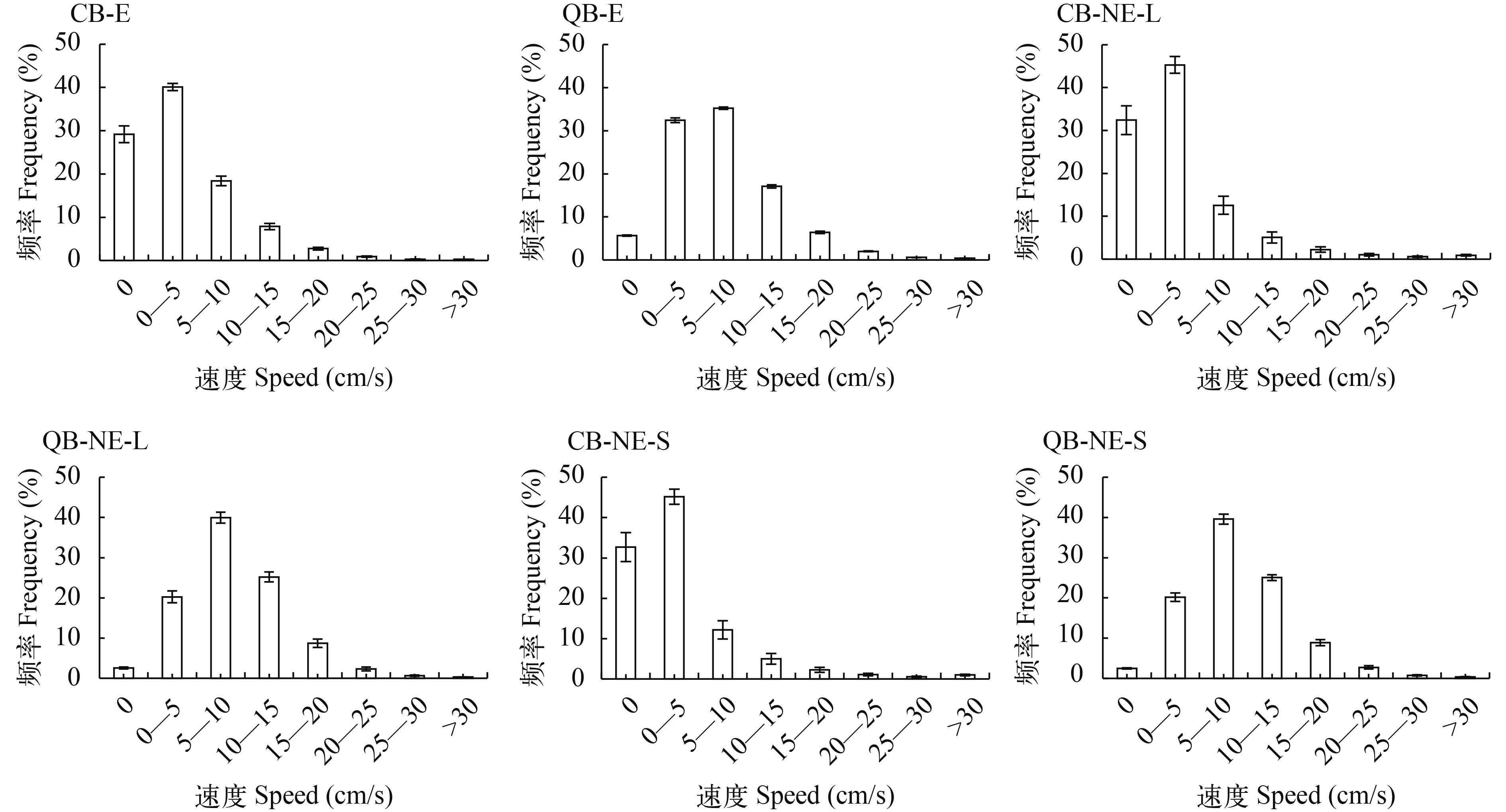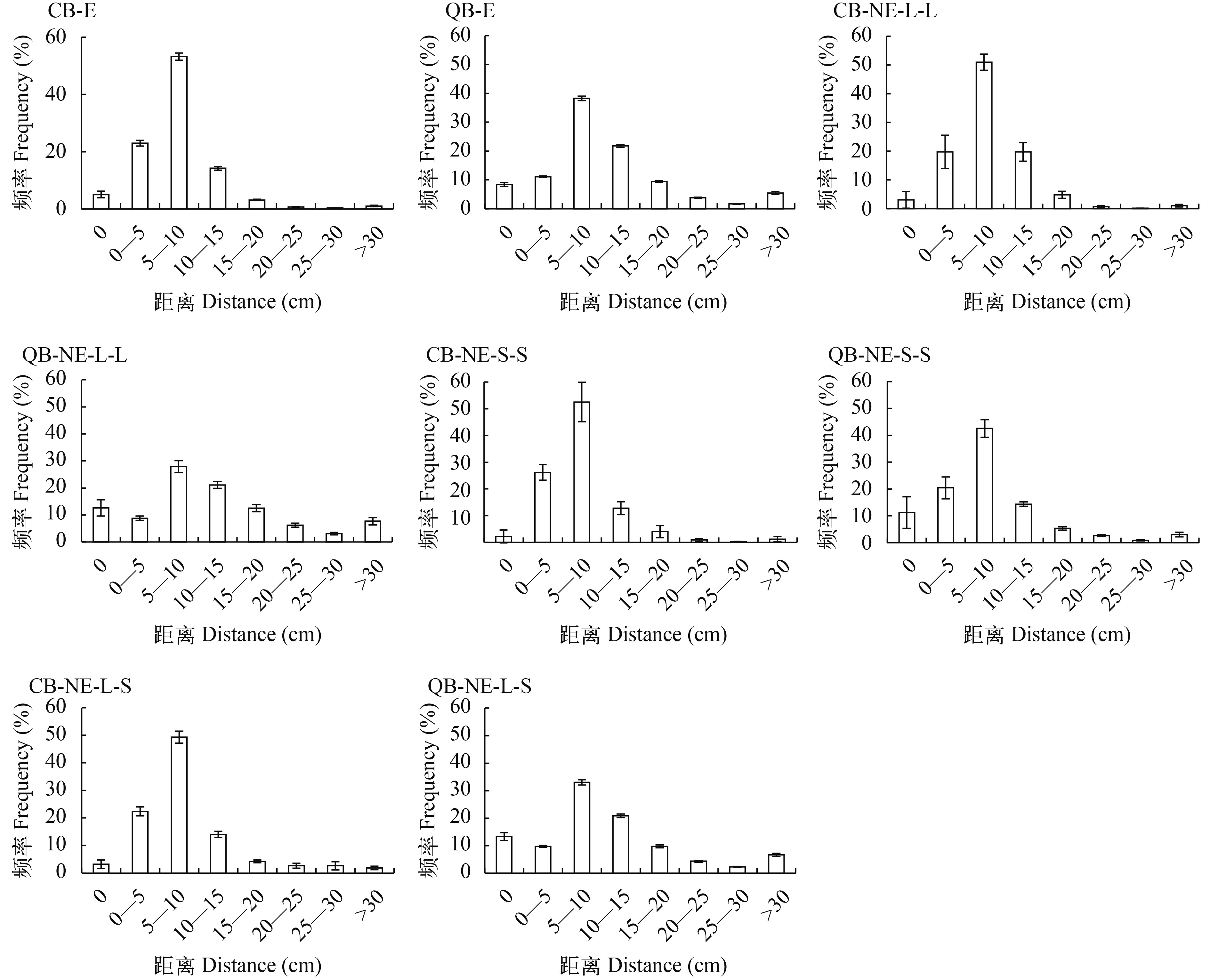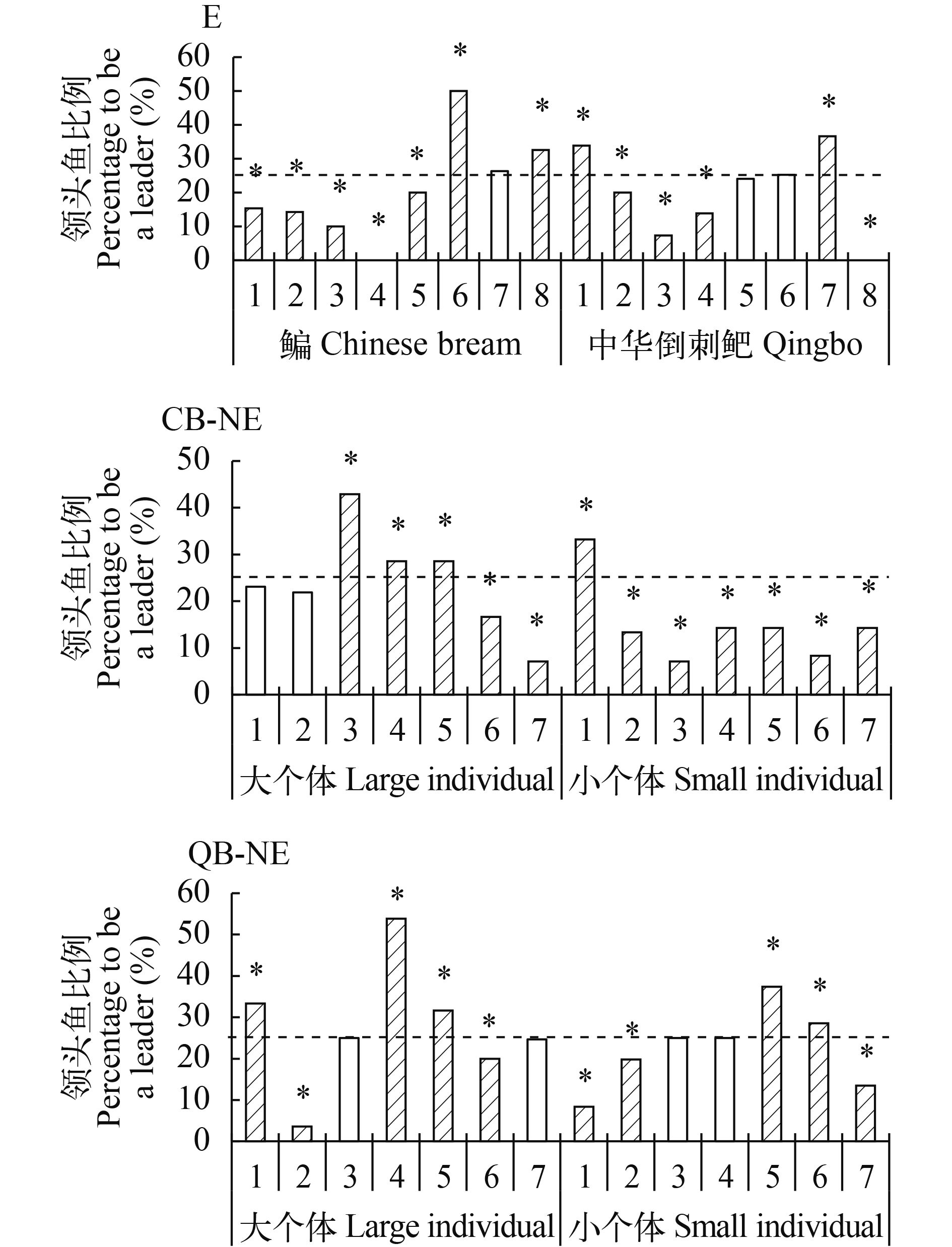EFFECT OF BODY SIZE VARIATION OF GROUP MEMBERS ON SHOAL BEHAVIOR OF TWO CYPRINIDS PREFERRING DIFFERENT HABITATS
-
摘要: 为研究群体成员大小差异对不同喜好生境鱼类集群行为特征的影响, 实验分别以鳊(Parabramis pekinensis)和中华倒刺鲃(Spinibarbus sinensis)幼鱼为实验对象, 比较分析4尾等大小(E)和不等大小(2大2小, NE)实验鱼群体的自发游泳速度、空间分布以及对恐吓刺激反应等集群行为参数的差异。结果显示: (1)和鳊相比, 中华倒刺鲃有更高的自发游泳速度、速度同步性和排列方向的极性, 但二者对恐吓刺激的反应率及反应的协调一致性相似; (2)当群体成员大小出现差异时, 两种鱼群体排列方向的极性不受影响, 且大小个体成员间的速度及其同步性均没有差异, 但整体的速度同步性与等大小群体相比有所下降; (3)个体间距离数据显示, 个体大小差异不会影响两种鱼群体的凝聚力; (4)群体成员在两种鱼群中偏好位置不同, 当群体成员大小不同时, 大个体成员更偏好占据领头鱼位置; (5)群体成员大小的差异导致两种鱼对刺激的反应率下降。研究表明: 中华倒刺鲃具有更高的活跃性、更好的群体运动的协调性, 可能与其流水生境相关; 当群体成员大小出现差异时, 成员不分大小在整体上协调运动的速度和方向, 并保持群体有较高的凝聚力, 但两种鱼类自发游泳速度调整策略截然不同(鳊大小个体速度妥协趋同, 而中华倒刺鲃低速个体速度提高); 群体成员大小差异导致鱼群对恐吓刺激的反应率有所下降, 可能原因包括体形差异导致的社会因素造成敏锐性下降、信息交流效率受阻和(或)集群收益代价出现分化影响一致决策的形成等。Abstract: The phenotypic composition of groups affect ecological and social processes, which is crucial for collective behavior research. To explore the influence of body size variation on shoal behavior between two cyprinids with diffe-rent habitats, the juvenile Chinese bream (Parabramis pekinensis) preferring still water and Qingbo (Spinibarbus sinensis) enjoying flowing water were selected to study spontaneous swimming behavior, spatial structure and the response to startling stimulus of fish groups including four similar fish individuals or including two larger and two smaller fish individuals. The results showed that the spontaneous swimming speed, the synchronization of speed and the alignment polarity of the juvenile Qingbo were significantly higher than those of Chinese bream, and that the responses to frigh-ten stimulus were similar between two species. The polarities of equal-size groups were similar to those of non-equal groups while the non-equal groups showed lower synchronization of speed in both species. However, all measured variables were not different between large and small size individuals within non-equal size group. The difference in body size did not impact group cohesion. The larger individuals of heterogeneity in spatial structure preferred to stay at the front of fish shoal. The flow regime habitats of Qingbo may explain its higher activeness and synchronization of swimming speed and alignment polarity than Chinese bream. Group members with different body size can coordinate their swimming speed and direction of movements even with higher group cohesion. Interestingly, smaller Qingbo indivi-duals elevated their speed to keep pace with larger individuals whereas Chinese bream individuals adjusted their speed to a moderate value. Variation of body size decreased the response ratio to frighten stimulus, possibly due to decreased response acuity to external stimulus as a consequences of social factor (e.g. social hierarchy), and impaired efficiency of information flow and (or) the divergence of ecological benefits and costs between larger and smaller size individuals, which subsequently influenced the consensus decision making.
-
Keywords:
- Chinese bream /
- Qingbo /
- Cohesion /
- Coordination /
- Group position /
- Stimulus response
-
-
图 2 鱼群个体大小差异对鳊和中华倒刺鲃的自发游泳速度及个体间速度异质性的影响(平均值±标准误; E组: N=8, NE组: N=7)
*表示同一大小处理不同种类间差异显著(P<0.05), a, b表示同一种类不同大小处理间差异显著(P<0.05); 下同
Figure 2. The effects of fish size on the spontaneous swimming speed and heterogeneity (Mean±SE; equal size group: N=8, non-equal size group: N=7)
* indicate a significant difference of same treatment between two species, a, b indicate a significant difference of different treatment within same species; the same applies below
表 1 不同实验组组别及其鱼体大小(平均值±标准误)
Table 1 The weight and length of fish under different treatments (Mean±SE)
种类 Species 组别 Group 组别及大小缩写 Abbreviations 重复数 Repetitions 体重 Body mass (g) 体长 Body length (cm) 鳊 Chinese bream 等大小 CB-E 8 3.25±0.12 5.95±0.07 不等大小 CB-NE-L 7 5.66±0.28 6.88±0.10 CB-NE-S 7 2.96±0.14 5.65±0.08 中华倒刺鲃 Qingbo 等大小 QB-E 8 4.03±0.10 5.69±0.06 不等大小 QB-NE-L 7 5.74±0.14 6.55±0.06 QB-NE-S 7 3.66±0.09 5.64±0.05 表 2 种类和鱼群成员大小差异对实验鱼群体特征影响的双因素方差分析
Table 2 The effects of fish species and size on shoaling behavior of two cyprinids based on a two-way analysis of variance (ANOVA)
游泳速度 Swimming speed 速度异质性 Speed heterogeneity 个体间距 Distance 群体极性 Group polarity 刺激反应率 Response ratio 反应一致性 Response conformity 种类 Species df 1, 38 1, 51 1, 50 1, 26 1, 50 1, 50 F 51.838 166.646 7.162 5.405 0.438 2.776 P <0.001 <0.001 0.01 0.028 0.511 0.102 大小Size df 2, 38 3, 51 3, 50 1, 26 3, 50 3, 50 F 0.785 25.425 2.936 0.414 6.548 1.33 P 0.463 <0.001 0.042 0.525 0.001 0.275 种类×大小 S×S df 2, 38 3, 51 3, 50 1, 26 3, 50 3, 50 F 0.789 1.893 3.897 4.139 0.54 0.595 P 0.461 0.143 0.014 0.052 0.657 0.621 -
[1] Victoria L P, James L, Roger K B, et al. Shoal choice in zebrafish, Danio rerio: the influence of shoal size and activity [J]. Animal Behavior, 2001, 62(6): 1085—1088 doi: 10.1006/anbe.2001.1858
[2] Ward A J, Axford S, Krause J. Mixed-species shoaling in fish: the sensory mechanisms and costs of shoal choice [J]. Behavioral Ecology Sociobiology, 2002, 52(3): 182—187 doi: 10.1007/s00265-002-0505-z
[3] Hoare D J, Krause J, Peuhkuri N, et al. Body size and shoaling in fish [J]. Journal of Fish Biology, 2000, 57(6): 1351—1366 doi: 10.1111/jfb.2000.57.issue-6
[4] Killen S S, Fu C, Wu Q Y, et al. The relationship between metabolic rate and sociability is altered by food deprivation [J]. Functional Ecology, 2016, 30(8): 1358—1365 doi: 10.1111/1365-2435.12634
[5] Rodgers G M, Downing B, Morrell L J. Prey body size mediates the predation risk associated with being " odd” [J]. Behavioral Ecology, 2015, 26(1): 242—246 doi: 10.1093/beheco/aru185
[6] Thünken T, Eigster M, Frommen J G. Context-dependent group size preferences in large shoals of three-spined sticklebacks [J]. Animal Behaviour, 2014, 90(1): 205—210
[7] Cote J, Fogarty S, Sih A. Individual sociability and choosiness between shoal types [J]. Animal Behaviour, 2012, 83(6): 1469—1476 doi: 10.1016/j.anbehav.2012.03.019
[8] Herbert-Read J E, Krause S, Morrell L J, et al. The role of individuality in collective group movement [J]. Procee-dings of Royal Society: Biological Sciences, 2012, 280 (1752): 20122564 doi: 10.1098/rspb.2012.2564
[9] Jennifer E S, Sergey G, Monique B M, et al. Leadership in mammalian societies: emergence, distribution, power, and payoff [J]. Trends in Ecology and Evolution, 2016, 31(1): 54—66 doi: 10.1016/j.tree.2015.09.013
[10] Farine D R, Montiglio P O, Spiegel O. From Individuals to groups and back: the evolutionary implications of group phenotypic composition [J]. Trends in Ecology and Evolution, 2015, 30(10): 609—621 doi: 10.1016/j.tree.2015.07.005
[11] Ranta E, Juvonen S K, Peuhkur N. Further evidence for size-assortative schooling in sticklebacks [J]. Journal of Fish Biology, 1992, 41(4): 627—630 doi: 10.1111/jfb.1992.41.issue-4
[12] Peuhkuri N, Ranta E, Seppa P. Size-assortative Schooling in Free-ranging Sticklebacks [J]. Ethology, 1997, 103(4): 318—324
[13] Jones K A, Croft A P, Ramnarine I W, et al. Size-assorta-tive shoaling in the guppy (Poecilia reticulata): the role of active choice [J]. Ethology, 2010, 116(2): 147—154 doi: 10.1111/eth.2010.116.issue-2
[14] 付世建, 聂利娟, 吴慧, 等. 群体大小对青幼鱼群体特征的影响. 生态学报, 2016, 36(19): 6062—6070 http://www.cnki.com.cn/Article/CJFDTOTAL-STXB201619009.htm Fu S J, Nie L J, Wu H, et al. The effect of group size on school structure in juvenile black carp [J]. Acta Ecologica Sinica, 2016, 36(19): 6062—6070
付世建, 聂利娟, 吴慧, 等. 群体大小对青幼鱼群体特征的影响. 生态学报, 2016, 36(19): 6062—6070 http://www.cnki.com.cn/Article/CJFDTOTAL-STXB201619009.htm[15] Hoare D J, Couzin I D, Godin J G J, et al. Context-dependent group size choice in fish [J]. Animal Behavior, 2004, 67(1): 155—164 doi: 10.1016/j.anbehav.2003.04.004
[16] Perez-Escudero A, Vicente-Page J, Hinz R C, et al. idTracker: tracking individuals in a group by automatic identification of unmarked animals [J]. Nature Methods, 2014, 11(7): 743—748 doi: 10.1038/nmeth.2994
[17] Miller N, Gerlai. From schooling to shoaling: patterns of collective motion in zebrafish (Danio rerio) [J]. PloS One, 2012, 7(11): 1—6
[18] Sybille H, Stefan F, Barbara T. Territorial aggression reduces vigilance but increases aggression towards preda-tors in a cooperatively breeding fish [J]. Animal Behaviour, 2016, 113(1): 229—235
[19] Katz Y, Tunstrøm K, Ioannou C C, et al. Inferring the structure and dynamics of interactions in schooling fish [J]. Proceeding of the National Academy of Sciences, 2011, 108(46): 18720—18725 doi: 10.1073/pnas.1107583108
[20] Harcourt J L, Ang T Z, Sweetman G, et al. Social feedback and the emergence of leaders and followers [J]. Current Biology, 2009, 19(3): 248—252 doi: 10.1016/j.cub.2008.12.051
[21] Nakayama S, Johnstone R A, Manica A. Temperament and hunger interact to determine the emergence of lea-ders in pairs of foraging fish [J]. PloS One, 2012, 7(8): e43747 doi: 10.1371/journal.pone.0043747
[22] Burns A L, Herbert-Read J E, Morrell L J, et al. Consis-tency of leadership in shoals of mosquitofish (Gambusia holbrooki) in novel and in familiar environments [J]. PloS One, 2012, 7(5): e36567 doi: 10.1371/journal.pone.0036567
[23] Brown C, Laland K N. Social learning of a novel avoi-dance task in the guppy: conformity and social release [J]. Animal Behaviour, 2002, 64(1): 41—47 doi: 10.1006/anbe.2002.3021
[24] Herbert-Read J E, Perna A, Mann R P, et al. Inferring the rules of interaction of shoaling fish [J]. Proceedings of the National Academy of Sciences, 2011, 108(46): 18726— 18731 doi: 10.1073/pnas.1109355108
[25] Pitcher T, Magurran A, Winfield I. Fish in larger shoals find food faster [J]. Behavioral Ecology and Sociobiology, 1982, 10(2): 149—151 doi: 10.1007/BF00300175
[26] Abbott J C, Dunbrack R L, Orr C D. The interaction of size and experience in dominance relationships of juve-nile steelhead trout (Salmo gairdneri) [J]. Behaviour, 1985, 92(3/4): 241—253
[27] Krause J, Godin J J. Shoal choice in the banded killifish (Fundulus diaphanus, Teleostei, Cyprinodontidae): effects of predation risk, fish size, species composition and size of shoals [J]. Ethology, 1994, 98(2): 128—136
-
期刊类型引用(3)
1. 张子慧,祝晓璇,姜佳枚. 长江口地区五种腹毛类纤毛虫的形态学研究. 水生生物学报. 2022(10): 1556-1562 .  本站查看
本站查看
2. 胡苗清,肖瑞琳,张志云,陈洁,梁爱华. 八肋游仆虫酸性核糖体蛋白基因克隆与特征分析. 水生生物学报. 2012(03): 546-551 .  本站查看
本站查看
3. 陈相瑞,马洪钢,朱明壮,胡晓钟. 青岛沿海7种异毛类纤毛虫形态学描述. 水生生物学报. 2011(06): 920-928 .  本站查看
本站查看
其他类型引用(1)




 下载:
下载:




